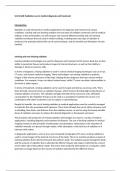Essay
Unit 21AB Alternative: Radiation use in Medical Diagnosis and Treatment - BTEC Applied Science
- Module
- Unit 21AB
- Institution
- PEARSON (PEARSON)
Unit 21AB Alternative: Radiation use in Medical Diagnosis and Treatment - BTEC Applied Science Distinction achieved :)
[Show more]



